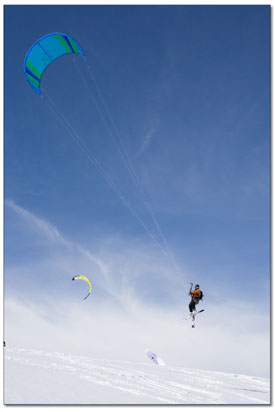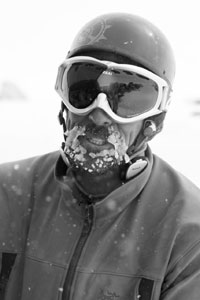| ||||
Addicted to wind
by Missy Votel Time for a bigger gear room. Just when you thought you had enough skis, bikes, boats, wakeboards and climbing gear to keep you happy for several lifetimes, along comes the latest outdoor recreational craze: snowkiting. OK, some may argue that a handful of local adrenaline junkies willing to strap themselves to a large kite while affixed to skis or a snowboard for the sake of flying (as in leaving the ground for extended periods of time, not as in “Dude, I was flying down Lower Bank”) does not a craze make. But, if anecdotal evidence is any indication, the latest death-defying pastime to hit the mountains is really beginning to take off, if you’ll pardon the pun. “The sport is definitely growing,” said Matt Vincent, who took up his first kite about seven years ago, ranking him as one of the forefathers of the U.S. snowkiting scene. “Over the last year, I’d say that local participation has doubled, and it’ll probably double again by next year.” In fact, in addition to a dedicated group of local snowkiters, Vincent said there is a large group in Denver (which uses Dillon Reservoir as its home base) with smaller contingencies sprouting up in Grand Junction, Taos and even Farmington. Snowkiting is even getting its very own publication, Drift, a Denver-based glossy expected to launch sometime this spring. Of course, there are no cold, hard snowkiting numbers because like any fledgling fringe extreme pursuit, there really is no rule book, step-by-step video or sanctioning body. Rather, it’s just a loose conglomeration of “kite-minded” individuals, who, thanks to the wonders of the internet and the bro grapevine, hook up for annual “events” (“never ‘festivals’”) to see who can go the fastest, go the biggest and, well, drink the most beer. Vincent, whose double life as co-owner of Ska Brewing makes him a popular sponsor on the event circuit, recently returned from the U.S. Open Snowkiting Masters, held in Skyline, Utah. For the last four years, Vincent, along with fellow local snowkiting pioneer Forrest Jones, has been sponsoring the event held near the sleepy-town-turned-snowkiting-mecca of Fairview, Utah. About 95 miles south of Salt Lake atop the Wasatch Plateau, Skyline is a sprawling, rolling swath of BLM land popular among kiters, snowmobilers and other outdoor recreationists. “For the first two or three years, no one really came to the events,” said Jones. “It’s big in Europe but it only gained momentum in the U.S. in the last two or three years.” This year, however, was a different story. In addition to culling snowkiters from throughout the West and the United States, the Skyline event also drew participants from as far away as Poland, Greece, New Zealand and Tahiti. Yes, Tahiti, as in sandy beaches, coconut trees and tropical breezes. Seems that snowkiting (known in Europe as “speed flying”) has its roots not on land, but in water. Think of it as the illegitimate offspring of skiing and kitesurfing, which is not to be confused with windsurfing. Although seemingly similar, windsurfing is a different animal altogether that involves a fixed sail and a sailboard. Kiters, on the other hand, are attached to a kite or “foil” via 100-foot ropes and a harness. Allegedly, the former also has a much higher learning curve, which can make for a little animosity when vying for the same waves. “Windsurfers sort of look at kitesurfers like alpiners look at snowboarders,” explained Jones. In fact, when kiteboarders first started showing up at popular windsurfing spots, like Hood River’s Columbia Gorge, they were often treated as outcasts. However, it didn’t take long for many windsurfers to convert. “A number of really badass windsurfers now kite,” said Jones. In fact, kitesurfing is where both Jones and Vincent got their start. In 2001, Vincent was on his honeymoon in the Dominican Republic when he first saw the irresistible spectacle of a man traipsing through the air and across the sea aided to a large kite. “I couldn’t pull my wallet out fast enough,” said Vincent, who immediately signed up for lessons. About a year later, Jones watched a kitesurfing video sent to him from a kayaker friend. “I immediately booked my trip to Cabarete (Dominican Republic) and signed up for lessons, without ever even seeing it in person,” said Jones. “I took lessons for three days, and my instructor barely spoke English.” Despite the language barrier, both became relatively proficient in the water version of the sport and took the natural progression of trying the newfound skill out on snow once back in landlocked Colorado. “I was jonesing and bought a kite from a kayaker passing through town that winter,” said Vincent. “Not knowing how to snowkite, I went up to Lemon Reservoir with a few friends and got pulled around and said ‘This is the greatest thing in the world.’”
Jones was having a similar revelation, and eventually, the two starcrossed kiters became fast friends. “I guess you could say we were pioneers as far as the Southwest is concerned,” said Jones. “We were the first people to ride places like Brazos (near Taos), the Grand Mesa, Molas, etc.” And while the two occasionally will hit up the lift-served on a powder day, they said snowkiting has become a bit of an obsession. “I probably have 12 kites, most that I no longer use,” admitted Vincent. Despite the hefty price tag (about $1,000 for a new kite and harness) the two say when it comes to time on the snow, the sport more than makes up for it. “In two hours, you can get in as much skiing on a kite as you would in a whole day at the resort,” said Jones. That’s because in addition to pulling skiers across flats and downhill, the kite is also used to pull skiers uphill. Think wind-powered, personalized tow rope. “One of the big misconceptions is that we kite on flat fields,” said Vincent. “But snowkiters actually like terrain. A small hill can become a lot of fun. In the time it takes a skier or border to hike up and ski down a jump, you can do several laps.” Then there’s the air – big, on-command air. “You’ll be going down, making turns, until you decide to jump. You can ride a cornice like a huge wave,” said Jones. Of course, if all this has you hawking your possessions and running out to the nearest snowkite dealer, be forewarned. Like most sports that look easy, snowkiting has a painful, potentially deadly, learning curve. “We still refer to them as loaded guns,” said Jones, who has clocked himself at top speeds of 68 mph using a GPS. “It’s like a two-hour tug-of-war.” Although the safety and release technology has improved over the years, there are hazards involved with kiting, namely stationary objects. “Buses, trees, buildings, anything that you can crash into, including the ground,” said Jones. To that effect, both have sworn off of teaching snowkiting, preferring to send would-be kiters (including their own spouses) to the pros. “Teaching somebody to kite is a lot of work,” said Vincent, “which is why I paid somebody to teach me.” In fact, over the last few years, snowkite instruction has sprouted up throughout the country, including Skyline, which is now home to several outfitters. But when asked if they’re worried about having to share all the fun, the two only shrug. They’ve still got plenty of their own secret stashes, and besides, what’s the use in keeping something so great to yourself? “It’s like an addiction, getting pulled around by the wind,” said Vincent. “All of a sudden, you start to look at the mountain in a whole new way, going uphill, in the opposite direction. I’ll never look at the resort in the same way again.” •
|



